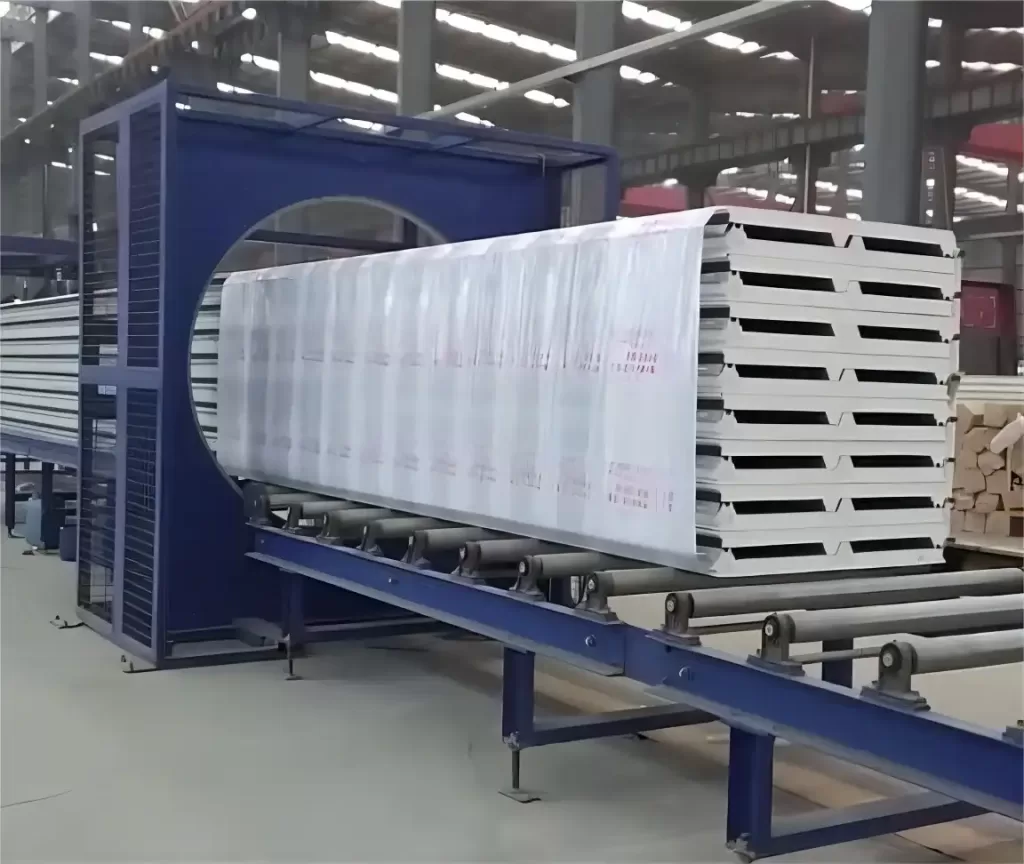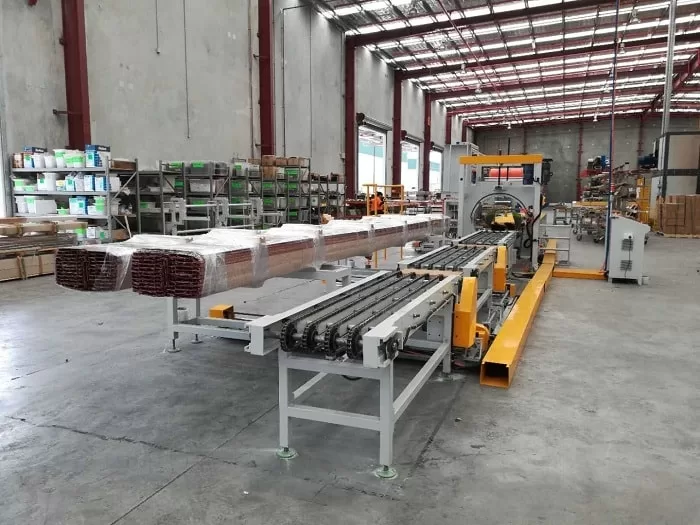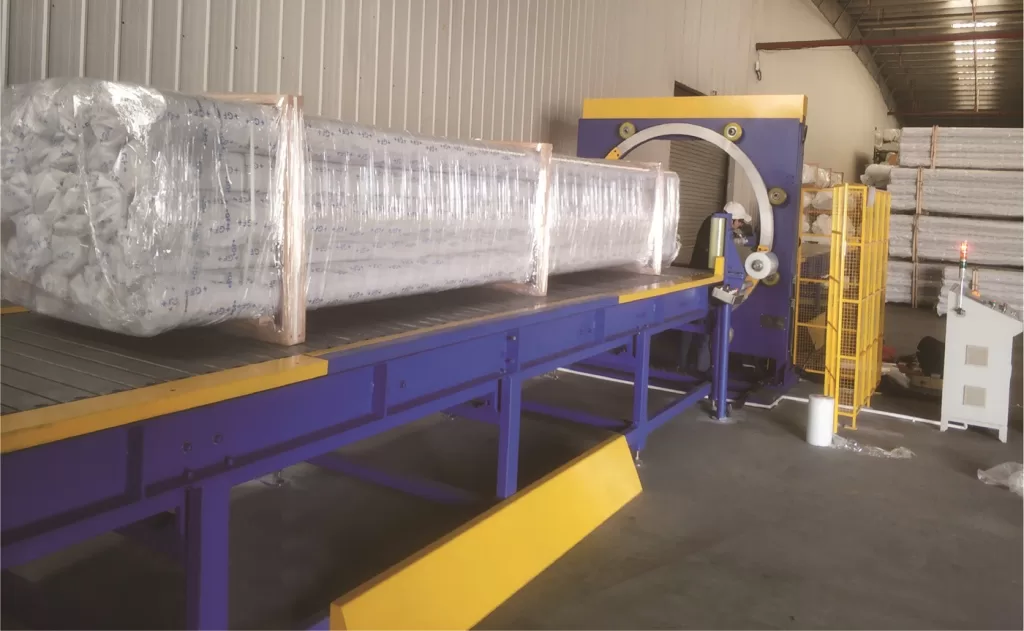Mastering Glass Packaging: Using Horizontal Stretch Wrappers Effectively
Packaging glass products, whether large architectural sheets, automotive windshields, or delicate panes, presents unique challenges. Ensuring these fragile items arrive intact requires a robust and reliable packaging method. Horizontal stretch wrappers offer an efficient and secure solution for unitizing and protecting glass during handling and transit. This guide details the best practices for utilizing horizontal stretch wrappers to safeguard your glass products.
Why Use a Horizontal Stretch Wrapper for Glass?
Horizontal stretch wrappers, also known as orbital wrappers, are particularly well-suited for long, flat, or irregularly shaped items like glass sheets. They offer several advantages:
- Enhanced Protection: Creates a tight, conforming layer of stretch film around the entire product bundle, shielding it from dust, moisture, and surface scratches.
- Improved Stability: Unitizes multiple glass pieces or secures protective packaging materials, significantly reducing movement and the risk of impact damage.
- Efficiency: Automates the wrapping process, increasing throughput compared to manual methods, especially for high-volume operations.
- Load Containment: Applies consistent tension, effectively holding components together during shipping and handling.

panel horizontal stretch wrapping machine Key Considerations for Wrapping Glass
Proper preparation and attention to detail are crucial before and during the wrapping process to prevent breakage.
1. Ensure Glass Stability and Protection
Glass sheets or panes must be securely stacked or arranged to prevent shifting.
- Padding: Utilize appropriate cushioning materials between glass pieces. Common options include:
- Cardboard sheets or edge protectors
- Foam pads or sheets (EPE, PU)
- Bubble wrap
- Corrugated plastic separators
- Interleaving paper or powder (for specific glass types)
- Function: Padding absorbs shock, prevents glass-on-glass contact, and provides stability within the bundle.
2. Maintain Consistent Orientation
The orientation of glass pieces must be uniform for effective wrapping.
- Sheets/Panes: Align all pieces in the same direction (e.g., all vertical or all horizontal).
- Curved Glass (e.g., Automotive): Stack consistently, often using specialized racks or dunnage.
- Importance: Consistent orientation ensures a balanced load and allows the stretch film to apply even pressure. Misalignment can lead to stress points and potential breakage.
3. Apply Strapping or Banding (Pre-Wrap Securing)
For many glass applications, especially larger sheets, securing the bundle before stretch wrapping adds critical stability.
- Materials: Use polyester (PET) strapping, polypropylene (PP) strapping, or specialized banding. Avoid steel straps directly on glass unless significant padding is used, as they can cause damage.
- Application: Wrap straps around the padded bundle at strategic points to hold the pieces firmly together. This prevents individual pieces from shifting during the orbital wrapping process. Ensure strapping tension is firm but not excessive to avoid damaging the glass edges.
4. Incorporate Spacers
Spacers help maintain separation and prevent shifting, particularly under the compressive force of the stretch wrap.
- Materials: Cardboard, wood, or dense foam blocks.
- Placement: Position spacers strategically along edges, between pieces, and especially at corners to distribute pressure evenly and maintain the bundle's shape.

horizontal orbital stretch wrapper with timber feeder and strapping machine Operating the Horizontal Stretch Wrapper
Correct machine operation is vital when handling fragile materials like glass.
- Machine Settings:
- Film Tension: This is critical. Apply enough tension to secure the load but avoid excessive force that could stress or break the glass. Start with lower tension settings and gradually increase as needed, testing carefully.
- Rotation Speed: Adjust the ring speed appropriate to the product length and stability. Smoother, controlled rotation is generally preferred for glass.
- Film Overlap: Ensure sufficient overlap (typically 50% or more) between film layers to create a strong, cohesive wrap.
- Wrapping Process:
- Feed the glass bundle steadily into the wrapping ring.
- Initiate the wrap cycle, monitoring the film application closely.
- Ensure the film applies smoothly without excessive pulling or tearing, especially around corners.
- Complete the wrap, ensuring the film tail is properly secured.
Post-Wrapping Procedures
1. Clearly Mark Packages
Proper labeling is essential for downstream handling.
- Content: Description of glass type, dimensions, quantity.
- Handling Instructions: Use universally recognized "Fragile" labels, "Handle With Care," and orientation arrows ("This End Up").
- Visibility: Ensure labels are large, clear, and placed on multiple sides of the package.
2. Provide Cushioned Support for Transport
When placing wrapped glass bundles onto pallets or into containers, further cushioning is necessary.
- Pallet Base: Use foam sheets, corrugated pads, or air cushions between the bottom glass package and the pallet deck.
- Between Bundles: If stacking wrapped bundles, use appropriate separators and cushioning between layers.
- Securing to Pallet: Secure the entire load to the pallet using heavy-duty strapping or additional layers of stretch wrap.
Common Mistakes to Avoid
- Insufficient Padding: Leads to glass-on-glass contact and breakage.
- Incorrect Film Tension: Too low fails to secure the load; too high risks breaking the glass.
- Poor Stacking/Orientation: Creates an unstable bundle prone to shifting.
- Skipping Pre-Bundling Straps: Allows individual pieces to move during wrapping.
- Inadequate Labeling: Results in improper handling during transport.

1horizontal wrapping machine gg1500 ce approved convey Conclusion
Using a HORIZONTAL STRETCH WRAPPER is an effective method for packaging glass products, but it demands careful preparation and execution. By focusing on stability, proper padding, controlled machine settings, and clear communication through labeling, fabricators and distributors can significantly reduce the risk of damage during handling and shipping. Implementing these best practices ensures that fragile glass products are protected efficiently and reliably.

